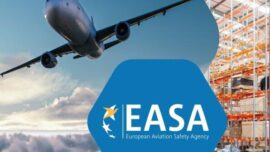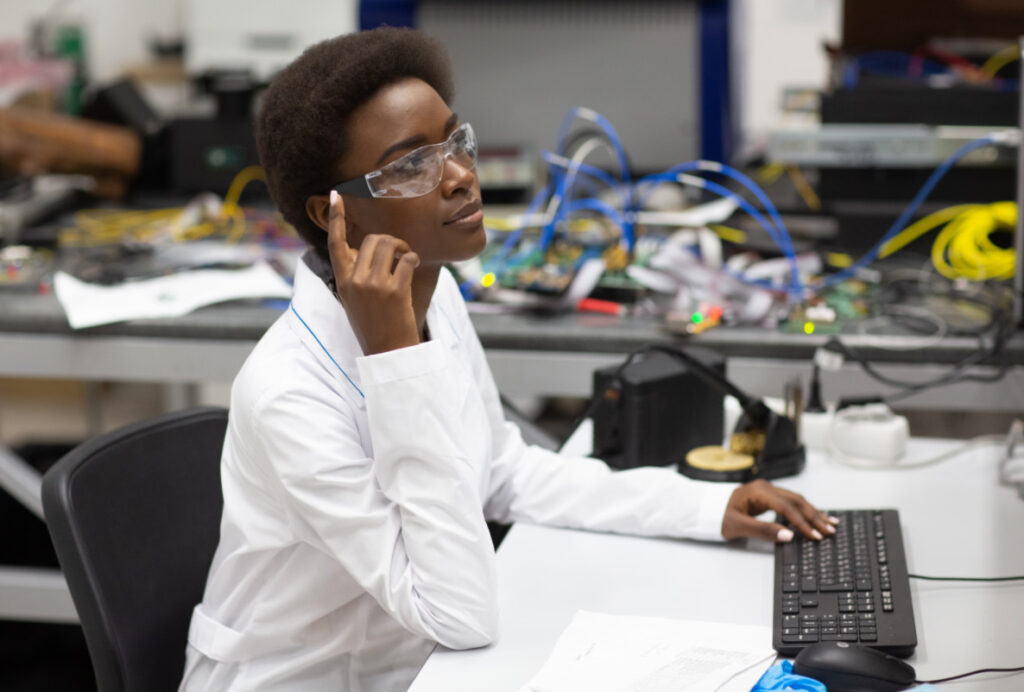Aircraft Engineering Program
Certified by the European Union Aviation Safety Agency (EASA), this program prepares you for a career in the Civil Aviation Industry especially those interested in aircraft maintenance. Students on this course have the opportunity to work on live aircraft at an Aircraft Maintenance Organization either in Ghana or overseas.
What does this career involve?
Careers in aviation expand beyond many industries, but Aircraft Engineering plays a crucial role in ensuring the safety and efficiency of aircraft travel.
Points to Consider Regarding Career Opportunities:
- Depending on which part of the world you are in, your experience and type ratings, Licensed Aircraft Engineers can earn from £12,000 at entry level to £50,000 or more annually with many years of experience. With flexible shift schedules, you can enjoy a good quality of life and job satisfaction.
- The demand for Licensed Aircraft Engineers remains high due to the ongoing growth in the aviation industry. Opportunities to work for major airlines and MRO’s are widely available.
- The role of Aircraft Engineers is vital in ensuring the safety and reliability of air travel, as planes cannot fly without their expertise and professional diligence.


What type of Engineer you want to be, will determine what qualification will you require. To help you choose, you will first need to understand something of the process of certification.
At Aerojet we train engineers and technicians to be certified to EASA Certification standards as this is the most widely accepted qualification for Aircraft maintenance personnel in the industry. The European Aviation Safety Agency (EASA) is the organisation that regulates all aviation activity within Europe and delegates authority for implementation of its regulations to its member National Aviation Authorities.
To ensure safety within the industry, engineering personnel are licensed in the same way as pilots and air traffic controllers. If suitably licensed an engineer can certify the work that has been carried out on an aircraft and return it to service.
There are several categories of licence which cover different levels and disciplines and, as in other professions, a variety of routes exist to achieve them. Let us deal with the type of work and the licences required first.
A Ramp or Line Maintenance Certifying Mechanic (Category A Licence Mechanic) is a person who is qualified to work on operational aircraft performing relatively minor maintenance tasks and replacement of parts that are required between major service overhauls and to subsequently certify these tasks; this work is generally done while the aircraft is in service, during turnarounds at airports or overnight.
Aerojet Academy only provides A Category license course training at the request of Aerojet Engineering on an on- demand basis. However, at the Academy our primary focus is training for the higher-level Category B License.
EASA Part-66 A, B1 & B2 Licenses

The Aircraft Maintenance Licence (AML) B1 Category allows the holder to issue certifications of release to service, following maintenance, including aircraft structure, power plants and mechanical and electrical systems. Authorisation to replace avionic line replaceable units (LRUs) requiring simple tests to prove their serviceability is also permitted. The Licence holder is qualified to work on aircraft that require more complex maintenance tasks or have been withdrawn from service for routine periodic servicing or major overhauls and re-fits and who can then subsequently certify his/her own and other work.
The Aircraft Maintenance Licence (AML) Category B2 allows the holder to issue certificates of release to service, following maintenance on avionic and electrical systems. A B2 Avionics Engineer specialises in scheduled maintenance, restoration and modification of communication, navigation, radar equipment, as well as guidance and control systems including auto-pilot/auto-land and cabin entertainment – generally all Electronic systems fitted to all aircraft across all categories.
For the purposes of the programs we offer at Aerojet Academy, we offer B Licence training as per the sub- categories shown below:
Category B Licences | |
|---|---|
B1.1 | Turbine Aeroplanes – Mechanical |
B1.2 | Piston Aeroplanes – Mechanical |
B1.3 | Turbine Helicopters – Mechanical |
B1.4 | Piston Helicopters – Mechanical |
B2 | Avionics |
The basic knowledge requirements refer to exams/modules that must be passed with a result superior to 75% of correct answers, such exams will be of the multiple choice type with three answers of which only one is correct. One of these exams, module 7 will have an essay question, in case of passing the multiple-choice part and failing the essay part, only the failed part will be re-examined. The validity of the exams is 10 years from the date of the first exam passed.
The exams to be taken vary according to the category of licence you wish to obtain.
See All Available Course Modules (registered users only)
Study Pathways
Select between any one of three study pathways available for this course.
The various pathways are designed with your convenience in mind, helping you achieve your license no matter what your lifestyle, budgetary or time constraints are.
EASA Part 66 Full-time Taught Programs
01. Four Year EASA Full-Time Program (with practical skills and work experience)
This is an Aerojet Engineering initiated structured training program. This program includes engineering practical handskills training as well as the EASA Mandatory Live Aircraft Environment/Experience Training in an EASA certified Part 145 Maintenance Facility, which is a pre-requisite for obtaining an EASA Part 66 License
Benefits of this course
- This course includes assistance with EASA Part 66 License application, after meeting all the exam and experience requirements.
- Successful completion of this program will lead to a guaranteed job with Aerojet Aviation or its partner facilities worldwide.
- For each annual application cycle, the top 50 highest scoring candidates on their entry aptitude test will be selected to go through a further assessment process to be considered for a full scholarship. Only 10 scholarship slots are available each year and the best 10 will be selected.
Course Times
Tuition times for our Four-Year Full-Time Program are typically 08:00 – 15:00 daily, Monday to Friday (excluding public holidays in Ghana)
02. Military/Company Certification Programme B1.1 or B2 (One Year)
This course is designed specifically for Military/Company personnel who have existing aircraft maintenance experience but no certification. Applicants must have at least 5 years verifiable experience to be considered for this program. This fast-track course is a strictly theoretical intensive program aimed at preparing students to pass all their EASA exams in preparation for their EASA Part 66 License.
Benefits of this course
- Discounted course for for military & company personnel only.
- This course includes guidance on EASA Part 66 License application process, after meeting all the exam and experience requirements.
- Candidates who successfully complete this training program with us will become eligible to apply for work experience slots at Aerojet engineering to meet their mandatory work experience requirement in an EASA Part 145 Facility.
Course Times
Tuition times for our Military Certification Program are typically 16.00 – 19.00 daily, Monday to Friday (excluding public holidays in Ghana)
Course Fees
Tuition Fees for courses commencing in 2024 are available on request via email to trainingprograms@aerojet-academy.com Our fees include all technical training notes & study material, tuition and examination fee.
NOTE: Custom training programs and certification courses for airlines, operators and groups can be organized and priced specifically for each customer where required.
EASA Part 66 Short Modular Courses (Assisted Learning Program)

These courses provide training in discrete Part 66 modules and is suitable for:
- Those looking to convert an existing non-European National licence into an EASA one at their own pace.
- Currently working with an airline as a non-certified technician looking to work towards their EASA Part 66 License at their own pace and convenience.
- Looking to extend one Part 66 licence category such as Category B1 to another such as a B2 or even an A1 to a B1.
Benefits of this Program
- The courses offer assisted learning for each module of the Part 66 syllabus.
- Candidates can attend scheduled classes at convenient times based on our timetable slots for the various modules which run all year round for modular training.
- Students can study at their convenience and tackle whichever module they want at any time.
Course Times
Tuition times for our modular program are typically 10.30 –12.30 (morning Sessions) and 16.00 – 19.00 (late afternoon sessions) Monday to Friday (excluding public holidays in Ghana)
Course Fees
Tuition Fees for current & upcoming courses are available on request or through your student portal. Our fees include all technical training notes & study material, tuition and examination fee.
IMPORTANT NOTES FOR OUR ASSISTED LEARNING MODULAR PROGRAM
- Our modular courses do NOT come with work experience or practical training; therefore, candidates must meet the full experience requirements as stated in the Part 66 Regulations by themselves. Owing to the intensive nature of this course we recommend applicants already have previous aircraft maintenance experience.
- Aerojet Academy delivers its Short-Modular courses at our facility on the Accra Technical Training Centre Campus in Kokomlemle Accra. All our modular courses are theory-based and delivered either face-to-face or remotely via video conference for some of our students on a pre-arranged case by-case-basis.
Exam-Only Option

You can also apply to sit for an EASA Part 66 Examination Only and you can find our current Examination timetable on Aerojet 2024/2025 Exam Schedule.
Candidates for the Exam Only option can study on their own and come and take their exams with Aerojet.
If it is your first time booking an exam or taking a course with us, please register on our Training Academy Portal in order to proceed.
Aerojet’s facility is a Certified EASA Part 147 Facility and as such all-EASA Examination rules will apply.
Bookings for exams can only be made from the dashboard on your student portal. Group bookings or enquiries into booking packages and options can be requested via trainingprograms@aerojet-academy.com. Please review our latest Exam Schedule – Q4 2024 and Exam Options information, to decide what best suits you.
All Exam pricing includes the exam fee, learning material and training notes, along with at least a one to two-hour online review for each module.
How to Apply
- Check our website and read through all the courses and programs that best suit your needs.
- Register on the Aerojet Academy Portal
- Book and make payment for your course by using any of the available Aerojet payment options.
- Receive confirmation of payment and enrollment information.
- Start your course and begin your journey to becoming an EASA Licensed Aircraft Engineer.
Aerojet Payment Options
-
Electronic payments, such as visa card or mobile money should be done using our online payment link when booking the course.
-
Payment and Booking of a course may also be done by Bank Deposit, Bank Transfer or Cheque. Kindly indicate your course code and your email address associated with your registration on our portal as a reference. Please note that all payments must be fully cleared before you can be enrolled onto your chosen course. Bank and transfer charges are to be borne by the student.






